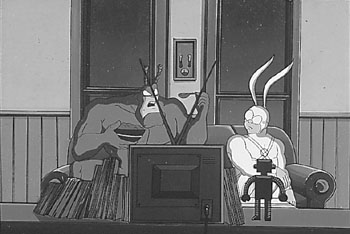Should Sidekicks Kiss?
Why television's 'Tick' is gayer than even 'Ellen'
By Zack Stentz
QUICK, NAME network television's most gay-positive show. Roseanne? Friends? Ellen? The last is the safe answer. The question of whether Ellen DeGeneres' character will come out on prime time or continue as a sitcom Rock Hudson has become a national media obsession, prompting Entertainment Weekly and even the august New York Times to devote space to the alleged "gay trend" sweeping television, with 22 openly gay characters currently on the air.
But in all the fretting over Frasier's arch dialogue and Ellen's choice of footwear, the Times and E.W. neglected to mention the most gay-friendly program of them all, The Tick (Saturdays on the Children's Network and Fox). TV's funniest cartoon boldly goes beyond the "my gay best friend" tokenism of prime time to explore the joys and heartbreaks of a gay couple living together in the 1990s.
Okay, not exactly. Ostensibly, the show focuses on the adventures of its 8-foot-tall arachnoid superhero and his moth-suit-wearing sidekick, Arthur, who both work nonstop to protect a metropolis called The City from evildoers.
For those unfamiliar with The Tick's oeuvre, the program derives much of its hilarity from juxtaposing the fantastic world of superheroism with the mundane realities of life. Unlike the anatomically perfect, independently wealthy Batman, for instance, Arthur struggles with his weight and has to sandwich his heroism around a rent-paying day job as an accountant, while the Tick's penchant for purchasing expensive crime-busting equipment leads to the ruination of his partner's credit rating.
Then there's the frenetic pop-culture referencing, with nods to Dr. Strangelove and Shaft plus a manic-depressive hero named Bi-Polar Bear and a popular restaurant called Bistro d' Burden.
Funny enough material for a kid's cartoon series, to be sure, but as with other great works of art, such as Michelangelo's paintings and the Village People's songs, the subtext is where The Tick gets really interesting. The show plays on the long history of sexually ambiguous hero-sidekick relationships, from modern pairings--the spouselike bickering of Riggs and Murtaugh in the Lethal Weapon films and the chicken-hawkish Batman-Robin bond--all the way back to the manly antics of Achilles and Patroclus and those very first Sumerian "special friends," Gilgamesh and Enkidu.
On the episode titled "The Tick vs. Dinosaur Neil," Tick and Arthur argue--a la The Birdcage--over the impending visit of Arthur's sister, Dot, who "doesn't approve of our superhero lifestyle." Not wanting to upset sibling relations, Arthur asks his roommate to "tone down" his heroic behavior, to which the Tick replies, "I'll control my urges." In the end, of course, Dot relents and gives her brother and the Tick her blessing to embrace their true natures, in this case saving The City from a titantic, mutant dinosaur.
Subsequent episodes deal with the Tick's jealousy over Arthur's budding relationship with a woman ("Sidekicks don't kiss!" he admonishes), Arthur's disapproval of his roommate's new mustache, and even the heartbreaks and societal disapproval of gay adoption, as when the pair take in an infant foundling who turns out to be telepathic villain Mr. Mental in disguise. In that instance, the Tick explores his maternal side, refers to himself and Arthur as "co-dads," and endures the stinging rebuke of a stranger who declares, "You people are sick!" upon first seeing the unorthodox family.
NAYSAYERS MAY argue that homosexuality gets only a metaphorical treatment in the show, but as film scholar Vito Russo chronicled in The Celluloid Closet, that's been the case ever since the very dawn of the moving image. The Tick wears its gay-friendly intentions on its sleeve far more honestly than cowardly pabulum like Fried Green Tomatoes, and did anyone ever really think "Y.M.C.A." was about the joys of swimming laps?
There's ample precedent to wonder at the deeper meaning of shows about two cohabiting men. The dynamic usually involves a fussy, repressed neurotic sharing space with an exuberantly physical, uninhibited sort of fellow. The Odd Couple (note the use of the word couple here, not buddies or pals) still stands as the most famous example, with Sesame's Street's Bert and Ernie coming in a close second, not to mention Chandler and Joey's oddly homoerotic relationship on Friends.
But none has gone as far as the Tick and Arthur, who will, we hope, continue to explore their feelings for each other in between bouts of battling criminal nemeses Chairface Chippendale, Man-Eating Cow and Omnipotus, Devourer of Worlds.
And maybe, just maybe, it's a sign of the progress gay and lesbian people have made in public acceptance, that the operative metaphor for homosexuality has now become superheroism. It sure beats the old ones of being compared to vampires, pedophiles and communists.
[ Metro | Metroactive Central | Archives ]
This page was designed and created by the Boulevards team.

Up, Up and Out of the Closet: The Tick and his sidekick, Arthur, have bonded more openly than any TV couple since Bert and Ernie.
From the October 31-November 6, 1996 issue of Metro
Copyright © 1996 Metro Publishing, Inc.
![[Metroactive Arts]](/arts/gifs/art468.gif)